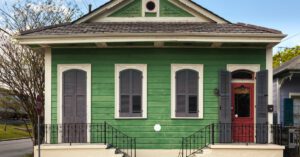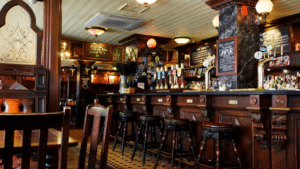Written by: Ryan Waller, Guelph real estate agent
Updated: July 10, 2024
Originally written: May 23, 2023
Tiny homes have gained a lot of press in recent years, as the City of Guelph along with the Province of Ontario are encouraging greater density to accommodate increasing home ownership and immigrants.
This blog will focus on the tiny home, or ARDU (additional residential dwelling unit) market- what they are, how they work and a local spin on regulations and how they will work in the City of Guelph!
Jump links:
Why all the interest in tiny homes?
Why are tiny homes now encouraged?
What’s the appeal of a tiny home?
How much does a tiny home cost?
Considerations when buying a tiny home
How do I build a tiny home in Guelph?
What is a tiny home?
Although tiny homes don’t have a specific size, most tiny homes are between 100- 600sf. A tiny home is a small, private and self-contained dwelling unit with living and dining areas, kitchen and bathroom, a sleeping area and year-round use
Why all the interest in tiny homes?
The Ontario Homes Built Faster Act pledges to increase the housing supply in Ontario by 1.5M homes over the next 10 years. As part of that, Guelph has pledged to increase their housing supply by building an additional 18,000 homes by 2031.
That pledge has Guelph reviewing a number of policies (30 in total) that may hinder production of homes. This includes processes that are run at a municipal level that are non-efficient and need to be expedited including:
- simplifying and improving the development approvals review process
- increasing staff for capital infrastructure projects that provide essential services like water and wastewater needed for new housing;
- partnering with service providers and construction industry partners to ensure they are aware of these housing targets
- end exclusionary zoning policies such as triplexes and ARDU (additional residential dwelling units) in residential zones
- much more- read the entire City of Guelph pledge
Why are tiny homes now encouraged?
Historically, Guelph has only allowed up to two units/ duplex/ ARDU (additional residential dwelling unit) in Guelph on a city designated residential lot.
So, this could mean on a city lot that you would have a semi detached (side by side units) or a duplex (for example, a bungalow with an upper and lower unit). Otherwise, more than two units, like a triplex were typically declined unless you had a grandfathered rental unit (also known as a “legal non conforming unit) or special exception.
And, anyone who has gone through the process of putting in an additional unit on their property has likely faced the frustration of wait times, red tape, municipal bureaucracy and costs.
Consider a 50’s bungalow sitting on prime real estate in the mid town parts of Guelph like Exhibition Park– many of them are on lots that are 50 x 100 feet or greater.
The house is situated on the front of the lot, leaving significant space that could be used to increase density with a tiny home.
The Province is viewing this sort of residential infill as an easy way to increase urban density and minimize urban sprawl.
What’s the appeal of a tiny home?
Twenty five years ago, the notion of living in a tiny home wasn’t something you would consider. In fact, it still isn’t considered a viable option for most people today. However, tiny homes are starting to become a little more mainstream for a variety of reasons.
The average price of a detached home in Guelph has crossed the $900,000 mark. So, most young people don’t have the financial means to purchase a property. This rapid rise in real estate prices has caused people to think differently- and more creatively for housing.
The appeal for tiny homes is becoming more and more. From smaller spaces to clean with little (sometimes no) utility costs, less environmental impact. Of course, they’re much cheaper than a detached home or condo.
How much does a tiny home cost?
Generally, you can expect to pay between $40,000 to $150,000 for a tiny home.
However like detached homes or townhouses, the price of a tiny home varies depending on a number of factors. Size and materials are the key factors.
Do you want to maximize the allowable size of your tiny home based on city by-laws? Do you want high end finishes in your tiny home? Where will you construct it?
Considerations when buying a tiny home
Construction materials
Is this a permanent structure on an existing city lot? Or, do you want it to be mobile (on wheels) to move to different locations?
This doesn’t only apply to exterior materials, but the quality of appliances and finishes such as backsplashes and countertops. Higher end finishes will cost more.
Home usage
will you use it yourself, or maybe as an income supplement like an AirBnB? If you’re living in it, you may have different needs than if you plan to use it as a rental in Guelph. The rental market is strong in Guelph, so this could be a great viable option.
Size
as mentioned previously, you’ll want to figure out how big it is. Naturally, this impacts the price.
Floorplan
depending on how creative you plan to be with the floorplan, it may impact the overall price. Standard layouts and models are cheaper than a custom build.
Pre-fab or built on site?
Where will you build the home? If pre-fab, you can build it anytime of the year in a warehouse and assembled on site. But, you may have hefty transportation costs. If built on site, it may be cheaper. But, can only build when weather permits so there could be some delays.
Local and provincial building code
There are rules and regulations when allowing for tiny homes. So does the City of Guelph. This is a relatively new venture for Guelph, there are many applications and guidelines that will be necessary.
How do I build a tiny home in Guelph?
Firstly, you need to know the basics of building a tiny home in Guelph. All of the details are here. However, to keep it simple here is a summary of what you require to build an additional dwelling unit. Note that this list is for a home that is NOT part of the existing dwelling:
- Cannot exceed 80 square metres (861 square feet) measured from the interior walls. Also, cannot exceed 45 per cent of the gross floor area of the main building. (all floor levels included)
- Can have a maximum of two bedrooms.
- Cannot occupy more than 30% of the yard, including all other accessory buildings and structures.
- The maximum building height is 5 metres, and cannot exceed the overall building height of the main dwelling.
- Is the additional residential dwelling unit is located above a detached garage? the maximum total building height is 6.1 metres, and cannot exceed the overall building height of the main dwelling.
- If you are planning to add another unit in an existing building, there are different rules for this.
Have questions?
Need more information on tiny home regulations in Guelph? Give Beth and Ryan Waller, Guelph real estate agents a call- they can help you!



